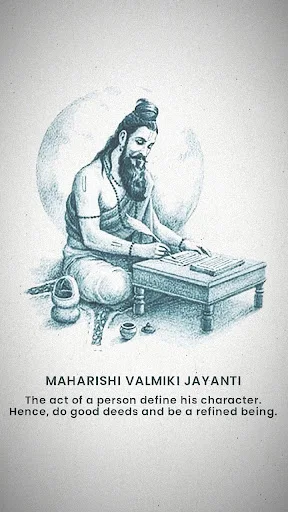In the annals of Indian mythology and literature, few figures stand as prominently as Maharishi Valmiki. Often hailed as the "Adi Kavi," which translates to the "first poet," Valmiki's legacy is intricately woven into the spiritual and cultural fabric of India. His most enduring contribution to humanity is undoubtedly the composition of the ancient Indian epic, the Ramayana, a narrative that continues to influence countless generations. To fully appreciate the life and works of this sage, it is essential to delve into the remarkable details that define his existence and the profound impact he has had on spiritual seekers and storytellers alike.
Valmiki's life story reads like a parable of redemption. In his earlier years, he bore the name Ratnakara, a notorious highway robber who made a living by preying on unsuspecting travelers. It was a life steeped in darkness and moral decay. However, destiny had other plans for him. Ratnakara's path took an extraordinary turn when he encountered the divine sage Narada Muni. The encounter with Narada's wisdom and spiritual guidance was transformative, stirring Ratnakara to the core. Profoundly moved by this divine intervention, he renounced his life of crime and embarked on a remarkable spiritual journey.
The transformation that unfolded was nothing short of miraculous. Through intense meditation and penance, Ratnakara underwent a metamorphosis and emerged as the sage Valmiki. His story serves as a beacon of hope, illustrating the fundamental belief in the power of inner transformation and the human capacity for redemption.
Valmiki's literary masterpiece, the Ramayana, is an epic poem that delves into the life and adventures of Lord Rama. This timeless narrative weaves a tapestry of virtue, righteousness, and the battle against the demon king Ravana. While Valmiki Ramayana does not have a direct connection to the tales of Bal Ganesh, both occupy distinctive places in Hindu mythology. The Ramayana lays down the ideals of dharma and righteousness, while Bal Ganesh, a playful representation of Lord Ganesha, captures the youthful and mischievous essence of the god of wisdom and new beginnings. These narratives, although distinct, contribute significantly to the rich tapestry of Hindu religious and cultural traditions.
The life and teachings of Maharishi Valmiki serve as an enduring testament to the potential for redemption and spiritual enlightenment. His journey from a hardened criminal to a revered sage encapsulates the core belief that every individual has the capacity for profound transformation. Valmiki's teachings underscore the importance of self-realization, virtuous living, and the pivotal role of storytelling and literature in conveying moral and spiritual values. The Ramayana, with its intricate narrative and timeless wisdom, continues to inspire and guide individuals on their spiritual journeys, serving as a perennial source of enlightenment and moral compass.
Valmiki Jayanti, celebrated as the birth anniversary of Maharishi Valmiki, is a day of deep reverence and spiritual significance for countless devotees across India. On this auspicious occasion, adherents pay homage to the sage by engaging in a range of rituals and practices. These may include visiting Valmiki temples, reading passages from the Ramayana, reciting Valmiki's hymns, offering prayers, and distributing food to the less fortunate. It is a day for introspection and contemplation, a time when devotees reflect upon the sage's immense contributions to literature and spirituality. Cultural programs and events are often organized to celebrate the timeless legacy of Maharishi Valmiki and his enduring influence on Indian culture.
the life and works of Maharishi Valmiki exemplify the transformative power of redemption and the profound impact of storytelling. His journey from a life of crime to sagehood, coupled with the literary brilliance of the Ramayana, continues to inspire and enlighten individuals on their spiritual quests. Valmiki Jayanti serves as a poignant reminder of the sage's enduring legacy, symbolizing his abiding influence on Indian culture and spirituality.















